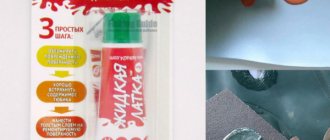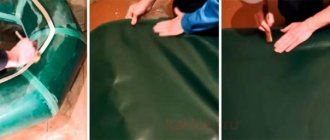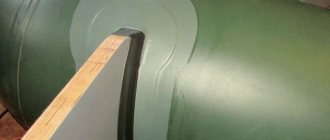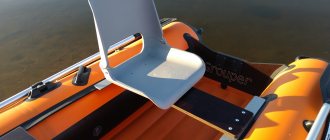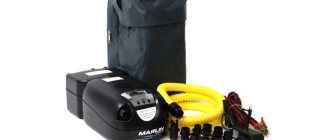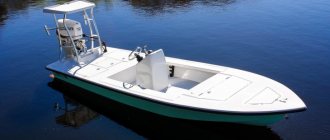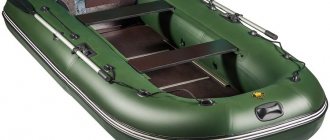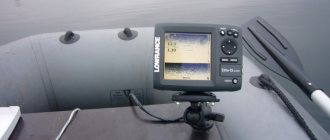Boat preparation
Before repairing, you need to find the hole; it is worth remembering that there may be several damages. Punctures are not always noticeable. Therefore, the inflated boat must be inspected in the water. When holes are found, you need to circle them with a marker or something else so as not to repeat the search procedure.
Then the boat descends. No glue will hold the patch when air whistles out from under it. You need to place a flat object under the damaged area: a board, container, stone, etc., whatever is at hand. The base should not sag when pressed.
Before sealing a PVC boat, you need to clean it from dirt and degrease it. To do this, you can use gasoline, toluene, thinner, alcohol or vodka. Acetone can damage PVC, so its use is not recommended. You cannot use sandpaper or anything like that, because... It's easy to damage the boat and make the holes bigger. The degreaser must completely evaporate from the surface. Only in this case can you start gluing.
Advantages of Liquid Patch glue
Distinctive features of the “liquid patch” that made it popular.
- High adhesion rate. The composition creates a strong bond between the edges of the damage, as it penetrates into the top layer of the material.
- UV resistance. Does not change its performance when exposed to UV and direct sunlight.
- The principle of vulcanization. Penetrates the material, creating a new top layer.
- Elasticity. After drying, it repeats the properties of the base material.
- Resistant to damage. The composition is not afraid of scratches and punctures.
- Low cost. The price of one 40 gram tube of glue varies between 400 rubles.
- Ease of use. Instructions for use are indicated on the packaging and consist of three short points: degrease, wait, and let dry.
What are the advantages of Liquid Patch glue for filling holes
? What else do you need to know about Liquid Patch glue?
- The drying time for this glue is 24 hours. However, absolute strength from the “Liquid Patch” can be expected 8-10 days after repair.
- It is highly resistant to temperatures above 50, freezes at -16 degrees Celsius.
- The glue should be stored in a cool, dark place, as far as possible from open fire and heating appliances.
- The shelf life of this product is two years from the date indicated by the manufacturer on the tube.
- You can purchase the product in Russia, Ukraine and Belarus.
How to use Liquid Patch glue to repair inflatable products
Repair of inflatable PVC boats. Repairing punctures.
What you will need:
- "Liquid patch";
- degreaser;
- pump.
Instructions:
- Pump the air out of the boat using a pump.
- Lay out the boat in a way that makes it convenient for you to work with it.
- Degrease the surface on which the glue will be applied. To do this, you can use alcohol, vodka, acetone, or nail polish remover.
- Knead the tube of glue with your hands.
- Apply the composition in a dense, thick layer to the damaged area. Leave for 24 hours until completely dry.
VIDEO INSTRUCTION
Elimination of cuts.
What you will need:
- "Liquid patch";
- degreaser;
- ordinary threads, needle;
- insulating tape;
- pump.
Instructions:
- Pump the air out of the boat using a pump.
- Sew the seam with regular thread. It is enough to apply several stitches to connect the edges of the cut.
- Knead the tube of glue with your hands. Apply a small amount of the mixture to the cut site. Leave for 24 hours.
- After this time, use insulating tape to mark the boundaries of the cut. This must be done in order not to apply an excess amount of glue and not spoil the appearance of the product.
- Apply a second coat and leave until completely dry.
VIDEO DESCRIPTION
Repair of air mattresses.
To repair a mattress, depending on the nature of the damage, you will need the same set of materials and tools as for repairing boats.
The procedure is exactly the same. The only difference is that the mattress is smaller, so the work will be less labor-intensive.
Patch
When the boat is ready, you need to prepare the patch. It is cut from similar material. It's best if you have a repair kit with you. As a rule, it contains the same fabric as on the watercraft.
The size and shape of the patch are determined by the size of the hole. The glued piece of fabric should extend 3-5 cm beyond the edges of the hole. The most commonly used patches are round, oval, rectangular and square. It is worth remembering that corners tend to cling and peel off.
The patch needs to be prepared in the same way as the boat: degrease and dry.
The last stage is fitting. The patch is applied to the puncture and traced along the contour of how it will lie.
How to choose the right glue and repair kit
The repair kit is specially designed for self-repairing a boat while traveling, so it contains everything you need, namely 6 fabric washers and glue specifically for PVC.
The repair kit is always sold complete with PVC boats, which is very convenient, but the glue tends to run out and dry out, so you just need to know a few tips for this case.
There must be glue:
- durable, to create a waterproof seam;
- resistant to both dynamic and static loads;
- resistant to elevated temperatures so that the glue does not spread in the heat;
- elastic.
What glue to seal a PVC boat with: choosing a product
The most important thing is what will connect the boat and the patch. It is the quality of the glue that determines the reliability of the repair. Of course, if you have a repair kit, then there won’t be any particular difficulties. However, it is not always at hand. What do you need to remember to choose the right product?
- Instant glue (such as “Second”, etc.) is not capable of providing high-quality repairs to PVC products. The patch will fall off as quickly as it sticks. In addition, cyanoacrylate compounds can “burn through” the material.
- To repair a boat, it is better to use polyurethane glue. This is exactly what is found in repair kits.
- Good glue, when dry, will not stick to your hands.
- It is better to opt for a special product.
- After drying, good glue, even its excess cannot be removed from the surface.
- Heat resistance is not the last factor you need to pay attention to when choosing adhesive. The higher this indicator, the better, because In the sun, the boat can get quite hot.
Repair materials
Once the cause of the boat's depressurization has been discovered, you can begin to eliminate it. To quickly and effectively repair detected damage, you will need:
- A repair kit that is included with the boat upon purchase.
- Scissors or knife.
- Roller or plate made of metal (plastic).
- Pencil.
- Brush.
- Solvent or acetone.
- Glue.
Often, many anglers have to deal with a situation where the glue from the kit thickens or dries out. Therefore, you have to buy it yourself. Particular attention should be paid to the choice of glue. It has certain requirements:
- have heat resistance (this is important when troubleshooting problems in the summer, when the surface being repaired gets very hot);
- have the required level of elasticity;
- be resistant to loads.
From the experience of fishermen, we can conclude that the glue included in the repair kit is only suitable for emergency repair of damage, that is, for repairs in field conditions. If this glue was used, then upon returning from fishing it is better to redo the repair of the damaged boat.
When choosing a glue you should pay attention to:
- On its composition. If the composition contains resins, then it is better to refuse the purchase, as they increase stickiness and the quality of gluing decreases.
- The glue tube states that the glue is heat-resistant. Under the influence of solar heat, the PVC material heats up, and the patch will peel off under the influence of heat.
- The indication on the tube “special” is preferable to “generic”. Special glue, taking into account the characteristics of the material, holds the glued surfaces better.
- Information on the tube “polyurethane”. This glue will provide high-quality and durable work to repair any damage.
You should not use glue from the “Moment” and “Superglue” series for repairs because during operation the glue layer cracks and air begins to escape freely through the cracks. And this will lead to the fact that very soon it will be necessary to do repeated repairs. Good repair results are given by adhesives of the brands “RK-2”, “Master Glue”, “UR-mono”, “Vinikol-1520”, “900I”, “PENOSIL Fix Go” - polyurethane glue, as well as durable and reusable glue “KERNIL” "
To ensure high-quality gluing of the patch and the damaged area, it is recommended to add “Polyisocyanate (grade B)” or “Desmodur” additives to the glue.
Mixing the glue and the selected additive is carried out in a proportion of 95-98% glue and only 5-2% additive by volume.
Instructions: how to seal a PVC boat
So, the boat and the patch are ready, degreased, and dried. The glue has been selected. You can collect everything into a single whole.
- The glue is applied to the boat and to the patch in a fairly thick layer. Then it should dry. Approximately 5-7 minutes. It is best to check the manufacturer's instructions for how long it will take.
- Then the glue is again applied to both surfaces, dries again and covered with a third layer. Again you need to let it dry.
- When the last layer is ready, you need to apply the patch to the boat and smooth it out. Now you need to heat it up. This is the main trick to how to properly seal a PVC boat. If at home, you can use a hairdryer. In nature, a mug of hot water will serve as a heating element.
- The hot patch needs to be pressed, it is best to roll it with something even and smooth, for example, a rolling pin, a bottle, etc. Then there will be no air bubbles, therefore, the gluing will be done efficiently.
- If the hole is significant, it is advisable to apply another patch on top of the one already glued.
- Allow the patch to cool and dry. As a rule, the glue gains strength within a couple of hours. If the repair was carried out under emergency conditions, then after 2-3 hours you can already sail to the mainland. But the boat will be completely ready in 2-3 days.
In case of a serious puncture
Sometimes quite serious holes appear in the side or at the bottom. Cuts or holes about 5 cm in size will not cause any difficulties. But if the snag has torn out a significant piece of fabric, then it is better to contact a specialist. Therefore, it is advisable to know where to seal your PVC boat in case of serious damage. Perhaps there are special workshops in the city. By the way, some tire shops also provide boat repair services.
Unfortunately, in some particularly difficult cases the boat may not be repairable. Then you'll have to buy a new one.
That's all for how to seal a PVC boat. With quality repairs, it will last for a long time.
